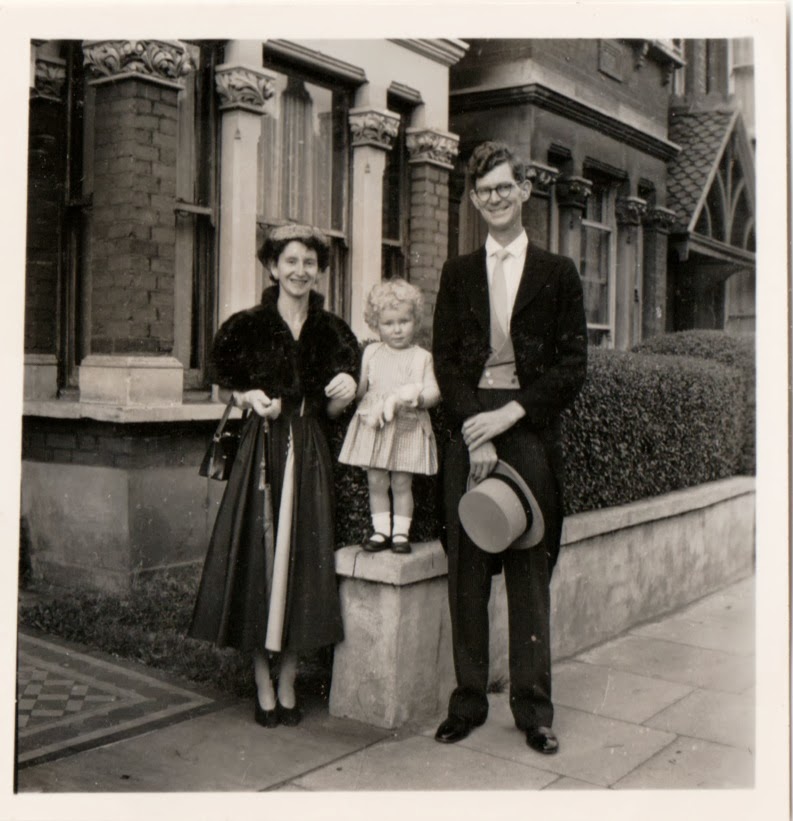For this week's topic, it's the crowded footpaths, old vehicles and trams that stand out for me in the photo prompt, and I found three similar streets in a calendar featuring old photographs of New Zealand.
 |
Lambton Quay, Wellington in the 1920s, photographer Sydney Charles Smith
Wellington is the capital of NZ, and in the 1920s it was clearly a busy place, with people intently going about about their business, whether it was work, shopping or socialising. Below is a photograph from my mother's album of her out shopping with her Aunty Ethel. Ethel Clarence Morrison, born in 1892, was the tenth child of Daniel and Mary Bridget Morrissey, who changed their surname to Morrison when they arrived in NZ from Ireland, apparently for ease of spelling. Ethel married John Thomas George Smith in 1924. The couple lived in Wellington and had no children themselves, but were enjoyed having their many nieces and nephews visit them for holidays. My mother Jean would have come up from Christchurch on such a visit, in the mid 1930s, a little later than the photo above, and they were smartly dressed and out on a shopping expedition in the city. Aunty Ethel looks determined to get whatever she is looking for! The tram tracks in the centre of the road are clearly visible in the photograph above, but the last tram in Wellington ran in 1964.
|

 |
| Colombo Street, Christchurch in the 1920s, looking towards the Cathedral. Photographer unidentified. |
Another 1920s photograph, this time of Christchurch around the same time period. Municipal trams ceased to run in 1954, and few if any of these buildings remain intact today, as a result of the devastation earthquakes that struck the city in 2010 and 2011. The cathedral itself was severely damaged, and the city centre still remains a scene of devastation, but the tourist tram that was introduced in 1995 on a short route around the city has resumed partial operation. My grandparents Jack and Mona Morrison lived in Aylmer St, which leads directly off Colombo St, about four kilometres south of Cathedral Square. In 1926 Jack Morrison proudly purchased the family's first car, and here he is showing it off outside their home, with his first son Ken standing on the running board. Who knows, it could even be that car seen turning into Colombo St.

 |
The extent of the recent devastation can be seen in this post-earthquake photo from 2011 taken by BeckerFraserPhotos showing a digger beside the rubble of the former Union Centre Building, 103-107 Armagh St, on the corner of which
the business of T. Armstrong & Co. Drapers was formerly located. Part of the building appears in the left foreground of the 1930s photograph. |
 |
| Queen Street Auckland city, 1949. New Zealand Freelance photograph. Photographer unidentified. |
The final photograph of the three from the calendar is a little later, taken in Auckland in 1949, and is a good example of the types of cars of the period, and shows how popular they were. The tramway system in Auckland closed down a few years later, in 1956. While I really don't have any family history connections to Auckland, a couple of my nieces currently live there. I doubt if they take much notice of the historical parts of the city, or would believe that traffic congestion was a fact of life over sixty years ago.
Melbourne in Australia is the only city in Australia or New Zealand that still operates a widespread and effective suburban tram network. Below is a photograph taken in Glenferrie Rd Malvern in 1911, on the occasion of the opening of the Dandenong Line.
Photograph from the online collection of the State Library of Victoria
Here's a photograph I took this morning from virtually the same view point, at the corner of Wattletree and Glenferrie Roads. The Tivoli Theatre is no longer there, but a fair number of the other buildings dating from the 1880s onwards still exist, and you can glimpse the town hall tower in the far distance, as per the original.
In colour:
And in black and white:
Below is a view of the major central intersection of Flinders and Swanston Sts in Melbourne City. Workers and shoppers would be coming or going from the impressively built Flinders St railway station. I didn't take a tram or train into town for a present day shot, but the scene today is much the same, minus the horses and carts, although there are horse drawn carriages that run through the city for the tourists. A design competition was recently held for extensive modernization of the station interior, but hopefully the historic facade of the Edwardian Baroque building built in 1905 will be preserved.
 |
| Flinders St Station intersection, c. 1927, unidentified photographer |
 |
| Flinders St intersection February 2014 |
Here's another photo from the SLV collection, of Balaclava Junction, North Caulfield, which is notable for being the only remaining 'grand union tram junction' in Australia, at which trams coming from any direction can go straight ahead or turn either left or right.
Here it is today, seen from another aspect. With that hazardous maze of overhead wires, oversize semi-trailers are definitely not welcome here! I was hoping to 'catch' several trams approaching from different directions to come into shot, but on a warm day the wait was too long. However google+ automatically added my various shots together and produced this motion video:
For more traffic chaos, drive over to
Sepia Saturday 215 and check out other Sepians' blogs.



.jpg)
.jpg)
.jpg)
.jpg)
.jpg)
.jpg)
.jpg)
.jpg)
.jpg)









.jpg)
































